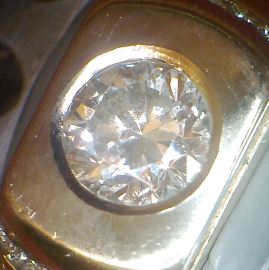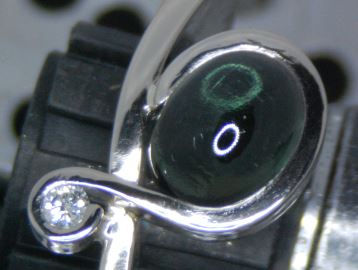Flush setting
Flush setting often looks very similar to bezel setting. The only distinction is that instead of being set in a raised ‘tube’, in flush setting the stone is set into the metal itself. For smaller stones, this means that the top of the stone will be flush with the metal surface, often even below it. Larger stones however, will sit above the metal anyway.

Flush set diamonds in gold
The techniques used in flush setting and bezel setting are similar. The metal is carefully hammered down until it securely grips the stone. Flush setting is more difficult to execute however, because the metal must be moved from the solid mass of the jewel itself. This requires a lot more force than bending a relatively thin outer wall of a bezel.

A man's ring with the center diamond in hammered setting
So although flush setting protects the stone even more than a bezel, it comes with its own disadvantages. The force required to move the metal in flush setting can by itself damage delicate materials. Also, because the stone sits deeper in the metal, it may lose some of its brilliance compared to other setting styles.

Flush set brilliant cut diamond and tourmaline cabochon
The previous picture shows a typical example of the overlap between bezel and flush setting. Both stones are set with their widest part at the same depth in the metal, technically this is flush setting. But when looking straight down, they look like set in bezels, albeit very wide ones that don’t wrap around completely. Though this is hard to see on the picture, the smaller diamond on the left barely extends above the metal, while the dome of the tourmaline cabochon on the right rises well above it. This is a consequence of the shape of the stones; the diamond is widest near its top, the cabochon near its bottom.
So we must conclude that ‘flush setting’ is really not a good name, even though it is widespread. The same technique has a lot of other, equally imprecise names, such as ‘gypsy setting’ and ‘shot setting’. A few other names describe the technique more precisely; ‘burnish setting’ or ‘hammer setting’ have our preference. ‘Burnishing’ is the technical term for rubbing a soft metal surface with a harder material while applying downward force. This modifies the shape of the softer metal and makes it reflective at the same time. Stones are still set in this way, but usually the micro setting hammer has replaced the burnisher in the modern workshop.
